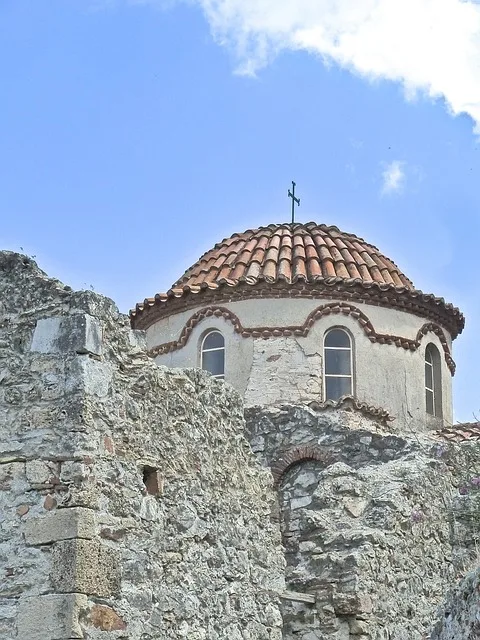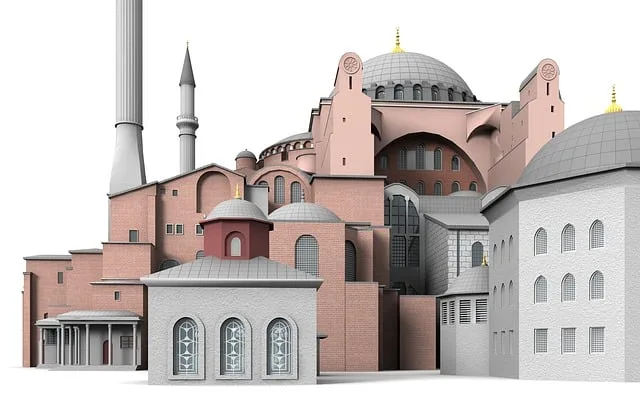Fast forward to 1453, when the Ottomans swept in and turned this architectural marvel into a mosque. The transformation was nothing short of dramatic. They added minarets, covered Christian icons with intricate Islamic calligraphy, and created a new spiritual atmosphere. It’s fascinating to think about how the same space can evoke such different feelings depending on its use. The Hagia Sophia became a symbol of the Ottoman Empire, blending cultures and religions in a way that few places can.
In 1935, the story took another twist when it was secularized and opened as a museum. This shift was like peeling back layers of paint to reveal the original masterpiece underneath. Visitors from all over the globe flocked to see its stunning architecture and rich history, marveling at how it encapsulated the essence of both Christianity and Islam.
Today, the Hagia Sophia stands as a testament to resilience and adaptability. It’s a living reminder of how places can evolve, reflecting the changing tides of history. Each brick, each mosaic, whispers tales of the past, inviting us to ponder the complexities of faith, culture, and identity. Isn’t it incredible how one building can embody so many stories?
From Sanctuary to Mosque: The Enduring Legacy of Hagia Sophia’s Transformative Journey
When you walk through its grand entrance, you can almost feel the weight of its legacy. The soaring domes and intricate mosaics tell stories of Byzantine glory, while the minarets that were added later echo the call to prayer, reminding us of its Islamic heritage. Isn’t it fascinating how a single structure can embody such diverse spiritual significance? It’s like a beautiful tapestry woven from threads of different beliefs and traditions.
Hagia Sophia’s transformation didn’t just change its function; it reshaped the cultural landscape of Istanbul. Each era left its mark, from the lavish decorations of the Byzantine period to the elegant Islamic calligraphy that adorns its walls today. This blend of styles creates a unique aesthetic that draws millions of visitors each year, eager to witness the harmony of its past.
But what does this journey teach us? It’s a powerful reminder of how places can evolve, reflecting the changing tides of society and faith. Just as we grow and adapt, so too can our spaces. Hagia Sophia stands as a testament to resilience and transformation, inviting us to ponder our own journeys. Isn’t it incredible to think that a single building can encapsulate the spirit of an entire city, bridging gaps between cultures and beliefs?
Hagia Sophia: A Timeless Testament to Faith, Power, and Architectural Marvel
As you gaze up at the magnificent dome, it feels like you’re staring into the heavens. The way it floats above the space is nothing short of miraculous, a feat of engineering that has inspired architects for generations. It’s as if the dome is a giant umbrella, sheltering the faithful beneath it while reaching for the sky. This architectural marvel has been a mosque, a museum, and now, a mosque once again, reflecting the ever-evolving tapestry of Istanbul’s rich history.

But it’s not just the structure that captivates; it’s the stories woven into its fabric. Each tile and stone has a narrative, from the whispers of Byzantine worshippers to the prayers of Ottoman sultans. Can you feel the weight of those stories? It’s like holding a piece of time in your hands, a reminder of how faith and power can shape a place.
Visiting Hagia Sophia is like stepping into a living history book, where every corner invites you to explore and reflect. It’s a place that transcends mere architecture; it’s a timeless testament to the human spirit, a bridge between cultures and eras, inviting everyone to marvel at its beauty and significance.
Echoes of the Past: How Hagia Sophia Reflects the Shifting Sands of History
Hagia Sophia has worn many hats over the years. Originally built as a cathedral in 537 AD, it was the heart of the Byzantine Empire, a place where faith and artistry danced together. Can you picture the vibrant ceremonies that once filled its halls? Fast forward to 1453, and it transformed into a mosque, echoing the call to prayer that resonated through the streets of Istanbul. It’s fascinating how this structure has adapted, reflecting the shifting sands of power and belief.
But it doesn’t stop there. In 1935, Hagia Sophia opened its doors as a museum, inviting people from all walks of life to marvel at its beauty. This shift symbolizes a broader narrative of inclusivity and shared heritage. It’s like a bridge connecting the past with the present, reminding us that history isn’t just about dates and events; it’s about the stories we carry forward.
As you wander through its vast halls, you can almost hear the echoes of the past—whispers of emperors, sultans, and everyday people who have walked these floors. Each visit is a journey through time, a chance to reflect on how this magnificent structure mirrors the ever-changing landscape of human experience. Isn’t it incredible how a single building can encapsulate so much history?
Hagia Sophia: The Architectural Wonder That Bridged Two Worlds
As you wander through its vast halls, you can almost feel the echoes of Byzantine emperors and Ottoman sultans. The intricate mosaics, shimmering like jewels, depict scenes that blend Christian and Islamic artistry, creating a visual feast that captivates the eye. It’s like a beautiful tapestry woven from the threads of different cultures, each adding its unique color and texture.
But what truly sets Hagia Sophia apart is its architectural brilliance. The way the dome seems to float above the nave is nothing short of miraculous. It’s as if the architects had a secret recipe for defying gravity! This innovative design not only influenced countless structures that followed but also symbolized the harmony between the East and West.
Sacred Spaces: The Evolution of Hagia Sophia Through Centuries of Change
But wait, the story doesn’t end there. Fast forward to 1453, and the Ottomans swept in, transforming this sacred space into a mosque. Talk about a dramatic plot twist! The minarets rose high, and the call to prayer echoed through the grand halls, blending Islamic artistry with the remnants of its Christian past. It’s like watching a masterful painting evolve, layer by layer, each brushstroke adding depth and meaning.

As centuries rolled on, Hagia Sophia became a museum in 1935, a neutral ground where people of all faiths could appreciate its beauty. Imagine the diverse crowd, each person marveling at the intricate details, each with their own interpretation of what this space means to them. It’s a melting pot of cultures and beliefs, a testament to humanity’s shared history.
Hagia Sophia’s Dual Identity: A Symbol of Unity and Division in a Changing World
Isn’t it fascinating how a single structure can represent such contrasting narratives? On one hand, Hagia Sophia symbolizes unity. It’s a place where diverse cultures and religions converge, showcasing the rich heritage of Istanbul. The intricate mosaics of Christ and the grand minarets that reach for the sky tell stories of coexistence. Visitors from all walks of life come together, marveling at its beauty, sharing a moment of awe that transcends their differences. It’s like a grand stage where everyone plays a part in a shared history.
Yet, on the flip side, Hagia Sophia also stands as a symbol of division. Its changing roles over the centuries reflect the shifting tides of power and belief. The debates surrounding its status today highlight the ongoing struggles between secularism and religious identity. It’s a bit like a family feud, where the same beloved heirloom becomes a point of contention. The very walls that once echoed with hymns now resonate with the calls to prayer, sparking discussions about cultural heritage and ownership.
In a world that often feels fragmented, Hagia Sophia reminds us of the delicate balance between unity and division. It challenges us to reflect on our own identities and the spaces we inhabit. Can we find common ground in our differences, just as this magnificent structure has done for centuries?
Frequently Asked Questions
What is the current status of Hagia Sophia today?
Hagia Sophia is currently functioning as a mosque, following its reconversion from a museum in 2020. It remains a significant cultural and historical site, attracting visitors for its architectural beauty and rich history.
Why was Hagia Sophia converted into a mosque?
The conversion of Hagia Sophia into a mosque in 1453 followed the Ottoman conquest of Constantinople. This change reflected the new Islamic governance and cultural influence in the region, as the structure was repurposed to serve the religious needs of the Muslim population while preserving its architectural significance.
What architectural features make Hagia Sophia unique?
Hagia Sophia is renowned for its massive dome, which appears to float above the central nave, creating an awe-inspiring interior space. The use of pendentives to support the dome is a significant architectural innovation. Its blend of Byzantine and Ottoman elements, including intricate mosaics and minarets, showcases a harmonious fusion of different architectural styles. The building’s vast scale, innovative structural techniques, and rich decorative details contribute to its uniqueness and historical significance.
How has Hagia Sophia’s role changed over the centuries?
Hagia Sophia has transformed significantly throughout its history. Originally built as a cathedral in 537 AD, it served as the center of Eastern Orthodox Christianity for nearly a thousand years. After the Ottoman conquest in 1453, it was converted into a mosque, reflecting the Islamic faith’s prominence in the region. In the 20th century, it was secularized and became a museum, symbolizing a blend of cultures and religions. Recently, it has reverted to a mosque, continuing to serve as a place of worship while also attracting millions of visitors as a historical landmark.
What is the history of Hagia Sophia’s transformation from church to mosque?
Hagia Sophia, originally constructed as a cathedral in 537 AD, served as the center of Eastern Orthodox Christianity for nearly a thousand years. Following the Ottoman conquest of Constantinople in 1453, it was converted into a mosque, reflecting the city’s new Islamic identity. Over the centuries, it underwent various modifications, including the addition of minarets and Islamic calligraphy. In 1935, it was secularized and transformed into a museum, symbolizing a blend of cultures. In 2020, it was reconverted into a mosque, reinstating its role in Islamic worship while still attracting visitors from around the world.

